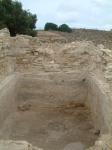Summary (English)
Since 1990, Genoa University has been excavating on the site of Nora as part of a project involving the universities of Milan, Padua, and Viterbo.
From 1996 onwards, the excavations have been concentrated in the northern area of the city that was occupied and urbanised at the end of the 6th century B.C. Here, G. Pesce’s excavations last century uncovered the Severan phase: the so-called macellum/_hospitium_, the Small Baths, and several houses, but caused the destruction of the data relating to the post 3rd century B.C. occupation.
In 2010, the new restoration work on the mosaic floors in the Small Baths provided the occasion for the opening of sondages inside and outside the structure in order to check the chronological phases.
The Small Baths were built at the 3rd century A.D. on a residential area. The first complex was simple (_frigidarium_, two tepidaria, calidarium) and was monumentalised in the 4th century, when an apodyterium, a corridor, and an entrance were added.
The baths ceased to function as such and were partially reoccupied for residential purposes and lastly were transformed (6th century A.D.) into workshops with kilns in the frigidarium pool and the tepidaria.
The 2014 campaign excavated the frigidarium pool, where it was possible to identify the build-up of structures beginning with the earliest square kiln that after a short period of use was substituted by a rapid succession of three kilns and related make-ups. This kiln was installed after the baths went out of use, but after a period of time and some sporadic occupation. This sequence was shown by the collapse of the pool’s marble sides underneath the earliest kiln phase. It was seen that following a first abandonment, the floor of the pool was robbed out, except for the parts to the sides that were more difficult to remove, while a small smelting kiln (bronze residue) was built in one corner and a small tank installed in the opposite one.Also in 2014 test trenches were dug prior to the construction of a roof to protect the apodyterium mosaic. The evidence from these trenches confirmed that the bath building was constructed on top of a domus, beside the road to the port, from one of which a section of the viridarium pool was recovered.
This season also saw the continuation of the excavations to bring to light towards the north the basalt-paved road E-F that crossed the quarter, parallel to another road (G-H), which bordered the area on the coastal side.
The 2012 excavations had identified two manhole covers from the sewer network and seen that the road travelled north-west suggesting that it was not the main road between Nora and Cagliari, but another internal route towards the landing place and port that must have been situated on the lagoon where the modern fishing port lies.
- Bianca Maria Giannattasio - Università degli Studi di Genova
Director
- Marco Minoja - Soprintendenza per i Beni Archeologici per le province di Cagliari e Oristano
- Maurizia Canepa - Soprintendenza dei beni archeologici per le province di Cagliari e Oristano
Team
- V. De Marco - Università degli Studi di Padova
- A. Parodi - Università degli Studi di Genova
- C. Tesserin - Università degli Studi di Genova
- M. Grippo - Università degli Studi di Genova
- S. Magliani- Università degli Studi di Genova
- Valentina Cosentino
Research Body
- Università degli Studi di Genova, Dipartimento Antichità, Filosofia, Storia (D.A.FI.ST.)
Funding Body
- Università degli Studi di Genova






![Download [PDF]](/excavation/skins/fasti/images/results/download_sml.png)